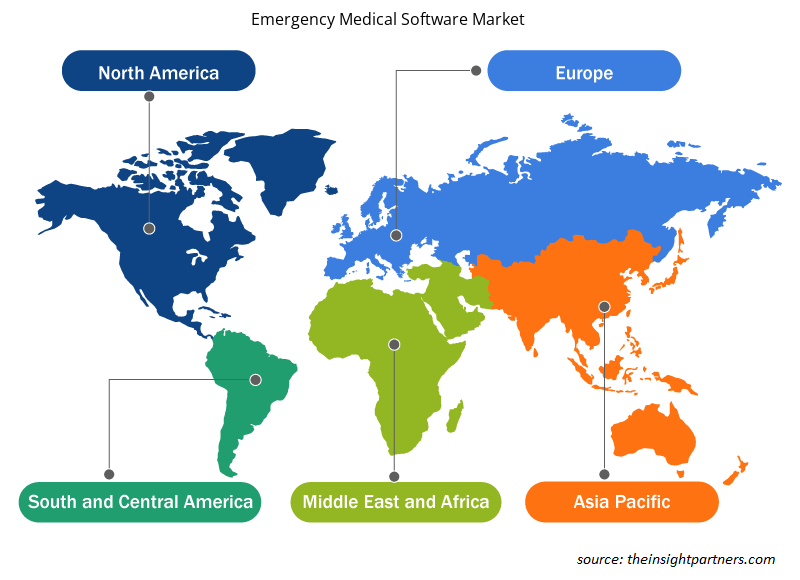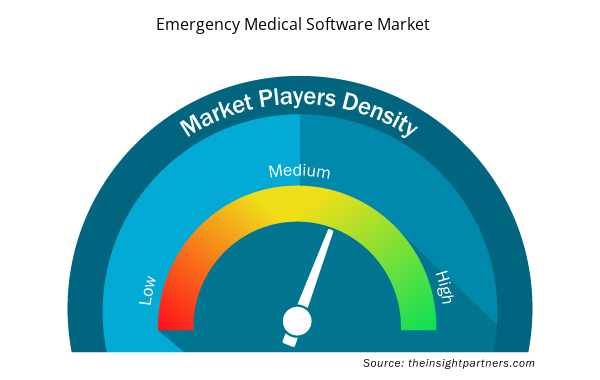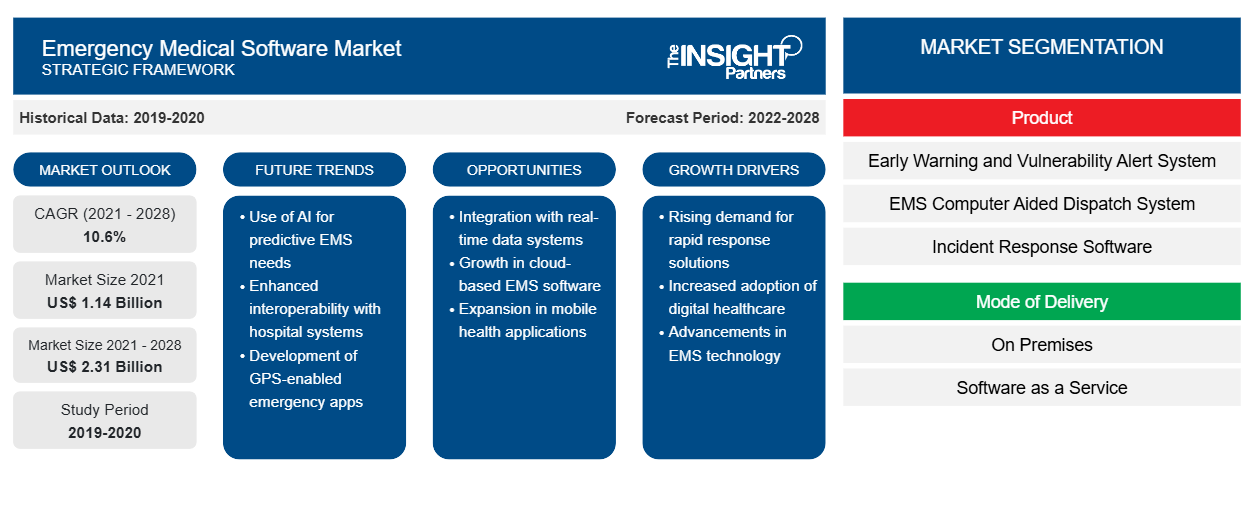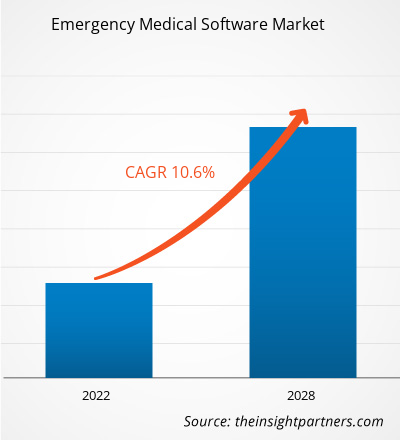Der Markt für medizinische Notfallsoftware soll von 1.144,91 Millionen US-Dollar im Jahr 2021 auf 2.313,20 Millionen US-Dollar im Jahr 2028 anwachsen; für den Zeitraum 2021–2028 wird mit einer durchschnittlichen jährlichen Wachstumsrate von 10,6 % gerechnet.
Notfallmedizinische Software wird verwendet, um auf medizinische Vorfälle zu reagieren und medizinische Notfallversorgung bereitzustellen. EMS konzentriert sich auf die medizinische Notfallversorgung der Patienten, wenn ein Vorfall schwere Krankheiten oder Verletzungen verursacht. EMS ist ein koordiniertes Reaktionssystem und eine medizinische Notfallversorgung, an der mehrere Personen und Behörden beteiligt sind. Ein umfassendes EMS-System besteht aus Vorfallerkennung, Notruf 911, Dispatch und Präventionsbewusstsein.
Der Markt für Notfallmedizin-Software ist nach Produkt, Lieferart, Plattform, Endbenutzer und Geografie segmentiert. Der Markt ist geografisch grob in Nordamerika, Europa, Asien-Pazifik, den Nahen Osten und Afrika sowie Süd- und Mittelamerika unterteilt. Der Marktbericht für Notfallmedizin-Software bietet Einblicke und eine eingehende Analyse des Marktes und betont Parameter wie die Größe des Marktes für Notfallmedizin-Software, Markttrends, technologische Fortschritte und Marktdynamik sowie die Analyse der Wettbewerbslandschaft der weltweit führenden Marktteilnehmer.
Passen Sie diesen Bericht Ihren Anforderungen an
Sie erhalten kostenlos individuelle Anpassungen an jedem Bericht, einschließlich Teilen dieses Berichts oder einer Analyse auf Länderebene, eines Excel-Datenpakets sowie tolle Angebote und Rabatte für Start-ups und Universitäten.
- Holen Sie sich die wichtigsten Markttrends aus diesem Bericht.Dieses KOSTENLOSE Beispiel umfasst eine Datenanalyse von Markttrends bis hin zu Schätzungen und Prognosen.
Das Wachstum des Marktes für Notfallmedizinsoftware ist auf die zunehmende Zahl traumatischer Verletzungen und steigende Gesundheitsausgaben zurückzuführen. Der Mangel an qualifizierten Fachkräften hemmt jedoch das Marktwachstum.
Markteinblicke
Zunehmende Fälle von Traumaverletzungen
Medizinische Notfälle wie Verkehrsunfälle sind weltweit eine der häufigsten Todesursachen. Laut der Weltgesundheitsorganisation (WHO) führten Verkehrsunfälle im Jahr 2021 zu etwa 1,3 Millionen Todesfällen. Darüber hinaus sind mehr als die Hälfte aller Verkehrstoten Fußgänger, Radfahrer und Motorradfahrer. Darüber hinaus gab die WHO an, dass 93 % der weltweiten Verkehrstoten in Ländern mit niedrigem und mittlerem Einkommen auftreten. Es wird erwartet, dass Verkehrsunfälle die häufigste Todesursache für Kinder und junge Erwachsene im Alter von 5 bis 29 Jahren sind. Darüber hinaus erhöht das Fahren von Fahrzeugen unter dem Einfluss von Alkohol oder psychoaktiven Substanzen oder Drogen das Risiko eines Unfalls, der zum Tod oder zu schweren Verletzungen führt. Dies ist einer der Hauptfaktoren, die zur steigenden Nachfrage nach geeigneten medizinischen Notfallsystemen wie Incident-Response-Systemen und Krankenwagenmanagementsoftware beitragen.
Im Jahr 2021 gab die WHO an, dass nichtübertragbare Krankheiten für 41 Millionen Todesfälle verantwortlich waren, was etwa 71 % aller Todesfälle weltweit entspricht. Darüber hinaus wurden im Rahmen der Global Burden of Disease im Jahr 2019 etwa 2,46 Milliarden behinderungsbereinigte Lebensjahre (DALYs) pro Jahr gemeldet. Diese Todesfälle sind auf vorzeitige Todesfälle und lang anhaltende Behinderungen zurückzuführen. Darüber hinaus wird einer Schätzung zufolge erwartet, dass in Ländern mit niedrigem und mittlerem Einkommen mehr als 50 % der Todesfälle und 40 % der gesamten Krankheitslast durch präklinische und Notfallversorgung vermieden werden könnten. Darüber hinaus belaufen sich die weltweiten Todesfälle und die vermeidbaren DALYs auf 24,3 Millionen bzw. 1.023 Millionen Leben. In Südasien sind 90 % der Todesfälle und 84 % der DALYs auf Notfälle und Traumata zurückzuführen. Die steigende Zahl der Traumata treibt also das Wachstum des Marktes für Notfallmedizinsoftware voran.
Produktbasierte Einblicke
Der globale Markt für Notfallmedizinsoftware ist nach Produkten segmentiert in Frühwarn- und Schwachstellenwarnsysteme (EWVAS), EMS- Computer-Aided-Dispatch- Systeme (CAD), Incident-Response-Software, Krankenwagenmanagement-Software und andere. Das Segment Incident-Response-Software hatte 2021 den größten Marktanteil. Darüber hinaus wird erwartet, dass dasselbe Segment im Prognosezeitraum die höchste durchschnittliche jährliche Wachstumsrate (CAGR) auf dem Markt verzeichnet, da das Produkt in der Praxis am häufigsten verwendet wird.
Erkenntnisse basierend auf der Lieferart
Der globale Markt für Notfallmedizinsoftware ist je nach Bereitstellungsart in On-Premise- und Software-as-a-Service-Software (SaaS) unterteilt. Das On-Premise-Segment hatte 2021 einen größeren Marktanteil. Es wird jedoch erwartet, dass das SaaS-Segment zwischen 2021 und 2028 eine höhere durchschnittliche jährliche Wachstumsrate verzeichnet, da Cloud-basierte SaaS-Systeme und -Lösungen stärker eingesetzt werden als On-Premise-Lösungen.
Plattformbasierte Einblicke
Der globale Markt für Notfallmedizinsoftware ist plattformbasiert in Windows, Android, iOS und andere segmentiert. Das Windows-Segment hatte 2021 den größten Marktanteil. Darüber hinaus wird erwartet, dass dasselbe Segment im Prognosezeitraum die höchste durchschnittliche jährliche Wachstumsrate (CAGR) auf dem Markt verzeichnet.
Regionale Einblicke in den Markt für Notfallmedizinsoftware
Die regionalen Trends und Faktoren, die den Markt für Notfallmedizin-Software während des Prognosezeitraums beeinflussen, wurden von den Analysten von Insight Partners ausführlich erläutert. In diesem Abschnitt werden auch Marktsegmente und Geografie für Notfallmedizin-Software in Nordamerika, Europa, im asiatisch-pazifischen Raum, im Nahen Osten und Afrika sowie in Süd- und Mittelamerika erörtert.

- Erhalten Sie regionale Daten zum Markt für Notfallmedizin-Software
Umfang des Marktberichts zur Notfallmedizinsoftware
| Berichtsattribut | Details |
|---|---|
| Marktgröße im Jahr 2021 | 1,14 Milliarden US-Dollar |
| Marktgröße bis 2028 | 2,31 Milliarden US-Dollar |
| Globale CAGR (2021 - 2028) | 10,6 % |
| Historische Daten | 2019-2020 |
| Prognosezeitraum | 2022–2028 |
| Abgedeckte Segmente | Nach Produkt
|
| Abgedeckte Regionen und Länder | Nordamerika
|
| Marktführer und wichtige Unternehmensprofile |
|
Dichte der Marktteilnehmer für Notfallmedizin-Software: Die Auswirkungen auf die Geschäftsdynamik verstehen
Der Markt für Notfallmedizin-Software wächst rasant, angetrieben durch die steigende Nachfrage der Endnutzer aufgrund von Faktoren wie sich entwickelnden Verbraucherpräferenzen, technologischen Fortschritten und einem größeren Bewusstsein für die Vorteile des Produkts. Mit steigender Nachfrage erweitern Unternehmen ihr Angebot, entwickeln Innovationen, um die Bedürfnisse der Verbraucher zu erfüllen, und nutzen neue Trends, was das Marktwachstum weiter ankurbelt.
Die Marktteilnehmerdichte bezieht sich auf die Verteilung der Firmen oder Unternehmen, die in einem bestimmten Markt oder einer bestimmten Branche tätig sind. Sie gibt an, wie viele Wettbewerber (Marktteilnehmer) in einem bestimmten Marktraum im Verhältnis zu seiner Größe oder seinem gesamten Marktwert präsent sind.
Die wichtigsten auf dem Markt für Notfallmedizin-Software tätigen Unternehmen sind:
- Quark Software
- Sun Ridge Systems, Inc.
- Trapeze-Gruppe
- Cerner Corporation
- GE-Gesundheitswesen
Haftungsausschluss : Die oben aufgeführten Unternehmen sind nicht in einer bestimmten Reihenfolge aufgeführt.

- Überblick über die wichtigsten Akteure auf dem Markt für Notfallmedizin-Software
Endbenutzerbasierte Erkenntnisse
Der globale Markt für Notfallmedizinsoftware ist, basierend auf dem Endnutzer, in kommerzielle, staatliche Stadtbehörden, kommunale und andere Segmente unterteilt. Das kommerzielle Segment hatte 2021 den größten Anteil und wird im Prognosezeitraum voraussichtlich die höchste durchschnittliche jährliche Wachstumsrate auf dem Markt verzeichnen. Der Markt für dieses Segment wird voraussichtlich ein stetiges Wachstum verzeichnen, da kommerzielle Räume unter strengen Standards und Richtlinien entwickelt werden, die das Vorhandensein von Früherkennungssystemen, Incident-Response-Software und mehr vorschreiben. Da auch private Krankenhäuser Teil des Segments sind, wird erwartet, dass der Markt für das kommerzielle Segment in den kommenden Jahren ein stetiges Wachstum verzeichnen wird.
Produkteinführungen und -zulassungen sind häufig von Unternehmen angewandte Strategien, um ihre globale Präsenz und ihr Produktportfolio zu erweitern. Darüber hinaus konzentrieren sich die Akteure auf dem Markt für Notfallmedizinsoftware auf die Partnerschaftsstrategie, um ihren Kundenstamm zu vergrößern, was ihnen wiederum ermöglicht, ihren Markennamen weltweit aufrechtzuerhalten. Es wird erwartet, dass der Marktanteil mit der Entwicklung neuer innovativer Produkte durch die Marktteilnehmer florieren wird.
Firmenprofile
- Quark Software
- Sun Ridge Systems, Inc.
- Trapeze-Gruppe
- Cerner Corporation
- GE-Gesundheitswesen
- ZENTRALER PLATZ
- Traumasoft
- AngelTrack LLC
- EMIS Gesundheit
- MEDHOST
- Episches Ems
- Historische Analyse (2 Jahre), Basisjahr, Prognose (7 Jahre) mit CAGR
- PEST- und SWOT-Analyse
- Marktgröße Wert/Volumen – Global, Regional, Land
- Branche und Wettbewerbsumfeld
- Excel-Datensatz



Report Coverage
Revenue forecast, Company Analysis, Industry landscape, Growth factors, and Trends

Segment Covered
This text is related
to segments covered.

Regional Scope
North America, Europe, Asia Pacific, Middle East & Africa, South & Central America

Country Scope
This text is related
to country scope.
Häufig gestellte Fragen
The emergency medical software market majorly consists of the players such as Quark Software Inc., Sun Ridge Systems, Inc., Trapeze Group, Cerner Corporation, GE Healthcare, CENTRALSQUARE, Traumasoft, AngelTrack LLC, EMIS Health, MEDHOST, Epic EMS.
Based on geography, the APAC region is accounted for highest CAGR in emergency medical software market during the forecast period.
The incident response software segment under product segment, held the largest share in 2021.
Emergency medical software are solutions that are used by hospitals, healthcare professionals, first responders, and paramedics to aid a coordinated effort towards providing emergency services to the public. The software tracks time, patient records, billing, and vehicle management, among other tasks for public and private emergency medical departments and organizations to streamline emergency medical efforts.
Trends and growth analysis reports related to Technology, Media and Telecommunications : READ MORE..
The List of Companies - Emergency Medical Software Market
- Quark Software
- Sun Ridge Systems, Inc.
- Trapeze Group
- Cerner Corporation
- GE Healthcare
- CENTRALSQUARE
- Traumasoft
- AngelTrack LLC
- EMIS Health
- MEDHOST
- Epic EMS
The Insight Partners performs research in 4 major stages: Data Collection & Secondary Research, Primary Research, Data Analysis and Data Triangulation & Final Review.
- Data Collection and Secondary Research:
As a market research and consulting firm operating from a decade, we have published and advised several client across the globe. First step for any study will start with an assessment of currently available data and insights from existing reports. Further, historical and current market information is collected from Investor Presentations, Annual Reports, SEC Filings, etc., and other information related to company’s performance and market positioning are gathered from Paid Databases (Factiva, Hoovers, and Reuters) and various other publications available in public domain.
Several associations trade associates, technical forums, institutes, societies and organization are accessed to gain technical as well as market related insights through their publications such as research papers, blogs and press releases related to the studies are referred to get cues about the market. Further, white papers, journals, magazines, and other news articles published in last 3 years are scrutinized and analyzed to understand the current market trends.
- Primary Research:
The primarily interview analysis comprise of data obtained from industry participants interview and answers to survey questions gathered by in-house primary team.
For primary research, interviews are conducted with industry experts/CEOs/Marketing Managers/VPs/Subject Matter Experts from both demand and supply side to get a 360-degree view of the market. The primary team conducts several interviews based on the complexity of the markets to understand the various market trends and dynamics which makes research more credible and precise.
A typical research interview fulfils the following functions:
- Provides first-hand information on the market size, market trends, growth trends, competitive landscape, and outlook
- Validates and strengthens in-house secondary research findings
- Develops the analysis team’s expertise and market understanding
Primary research involves email interactions and telephone interviews for each market, category, segment, and sub-segment across geographies. The participants who typically take part in such a process include, but are not limited to:
- Industry participants: VPs, business development managers, market intelligence managers and national sales managers
- Outside experts: Valuation experts, research analysts and key opinion leaders specializing in the electronics and semiconductor industry.
Below is the breakup of our primary respondents by company, designation, and region:

Once we receive the confirmation from primary research sources or primary respondents, we finalize the base year market estimation and forecast the data as per the macroeconomic and microeconomic factors assessed during data collection.
- Data Analysis:
Once data is validated through both secondary as well as primary respondents, we finalize the market estimations by hypothesis formulation and factor analysis at regional and country level.
- Macro-Economic Factor Analysis:
We analyse macroeconomic indicators such the gross domestic product (GDP), increase in the demand for goods and services across industries, technological advancement, regional economic growth, governmental policies, the influence of COVID-19, PEST analysis, and other aspects. This analysis aids in setting benchmarks for various nations/regions and approximating market splits. Additionally, the general trend of the aforementioned components aid in determining the market's development possibilities.
- Country Level Data:
Various factors that are especially aligned to the country are taken into account to determine the market size for a certain area and country, including the presence of vendors, such as headquarters and offices, the country's GDP, demand patterns, and industry growth. To comprehend the market dynamics for the nation, a number of growth variables, inhibitors, application areas, and current market trends are researched. The aforementioned elements aid in determining the country's overall market's growth potential.
- Company Profile:
The “Table of Contents” is formulated by listing and analyzing more than 25 - 30 companies operating in the market ecosystem across geographies. However, we profile only 10 companies as a standard practice in our syndicate reports. These 10 companies comprise leading, emerging, and regional players. Nonetheless, our analysis is not restricted to the 10 listed companies, we also analyze other companies present in the market to develop a holistic view and understand the prevailing trends. The “Company Profiles” section in the report covers key facts, business description, products & services, financial information, SWOT analysis, and key developments. The financial information presented is extracted from the annual reports and official documents of the publicly listed companies. Upon collecting the information for the sections of respective companies, we verify them via various primary sources and then compile the data in respective company profiles. The company level information helps us in deriving the base number as well as in forecasting the market size.
- Developing Base Number:
Aggregation of sales statistics (2020-2022) and macro-economic factor, and other secondary and primary research insights are utilized to arrive at base number and related market shares for 2022. The data gaps are identified in this step and relevant market data is analyzed, collected from paid primary interviews or databases. On finalizing the base year market size, forecasts are developed on the basis of macro-economic, industry and market growth factors and company level analysis.
- Data Triangulation and Final Review:
The market findings and base year market size calculations are validated from supply as well as demand side. Demand side validations are based on macro-economic factor analysis and benchmarks for respective regions and countries. In case of supply side validations, revenues of major companies are estimated (in case not available) based on industry benchmark, approximate number of employees, product portfolio, and primary interviews revenues are gathered. Further revenue from target product/service segment is assessed to avoid overshooting of market statistics. In case of heavy deviations between supply and demand side values, all thes steps are repeated to achieve synchronization.
We follow an iterative model, wherein we share our research findings with Subject Matter Experts (SME’s) and Key Opinion Leaders (KOLs) until consensus view of the market is not formulated – this model negates any drastic deviation in the opinions of experts. Only validated and universally acceptable research findings are quoted in our reports.
We have important check points that we use to validate our research findings – which we call – data triangulation, where we validate the information, we generate from secondary sources with primary interviews and then we re-validate with our internal data bases and Subject matter experts. This comprehensive model enables us to deliver high quality, reliable data in shortest possible time.


 Holen Sie sich ein kostenloses Muster für diesen Bericht
Holen Sie sich ein kostenloses Muster für diesen Bericht